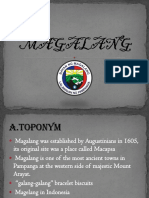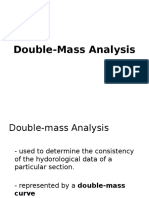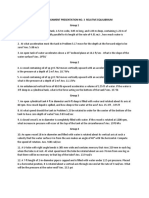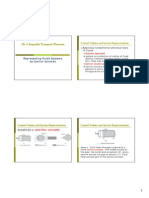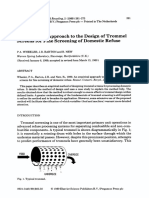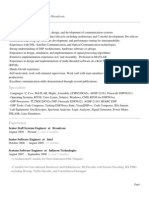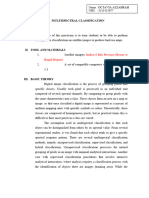0 ratings0% found this document useful (0 votes)
89 views5.1 Behaviour of Water in Rocks and Soils
5.1 Behaviour of Water in Rocks and Soils
Uploaded by
Hernandez, Mark Jyssie M.This document discusses key concepts regarding the behavior of water in rocks and soils. It covers:
1) The two main properties that control water behavior are porosity (how much water can be held in spaces) and hydraulic conductivity (how easily water can flow through).
2) Water exists in the vadose zone as gravity water and pellicular water, and becomes groundwater when it reaches the saturated zone.
3) Groundwater circulates within aquifers but its movement is limited by surrounding aquicludes, dividing the subsurface into hydrological units or basins.
Copyright:
© All Rights Reserved
Available Formats
Download as DOCX, PDF, TXT or read online from Scribd
5.1 Behaviour of Water in Rocks and Soils
5.1 Behaviour of Water in Rocks and Soils
Uploaded by
Hernandez, Mark Jyssie M.0 ratings0% found this document useful (0 votes)
89 views5 pagesThis document discusses key concepts regarding the behavior of water in rocks and soils. It covers:
1) The two main properties that control water behavior are porosity (how much water can be held in spaces) and hydraulic conductivity (how easily water can flow through).
2) Water exists in the vadose zone as gravity water and pellicular water, and becomes groundwater when it reaches the saturated zone.
3) Groundwater circulates within aquifers but its movement is limited by surrounding aquicludes, dividing the subsurface into hydrological units or basins.
Original Title
he
Copyright
© © All Rights Reserved
Available Formats
DOCX, PDF, TXT or read online from Scribd
Share this document
Did you find this document useful?
Is this content inappropriate?
This document discusses key concepts regarding the behavior of water in rocks and soils. It covers:
1) The two main properties that control water behavior are porosity (how much water can be held in spaces) and hydraulic conductivity (how easily water can flow through).
2) Water exists in the vadose zone as gravity water and pellicular water, and becomes groundwater when it reaches the saturated zone.
3) Groundwater circulates within aquifers but its movement is limited by surrounding aquicludes, dividing the subsurface into hydrological units or basins.
Copyright:
© All Rights Reserved
Available Formats
Download as DOCX, PDF, TXT or read online from Scribd
Download as docx, pdf, or txt
0 ratings0% found this document useful (0 votes)
89 views5 pages5.1 Behaviour of Water in Rocks and Soils
5.1 Behaviour of Water in Rocks and Soils
Uploaded by
Hernandez, Mark Jyssie M.This document discusses key concepts regarding the behavior of water in rocks and soils. It covers:
1) The two main properties that control water behavior are porosity (how much water can be held in spaces) and hydraulic conductivity (how easily water can flow through).
2) Water exists in the vadose zone as gravity water and pellicular water, and becomes groundwater when it reaches the saturated zone.
3) Groundwater circulates within aquifers but its movement is limited by surrounding aquicludes, dividing the subsurface into hydrological units or basins.
Copyright:
© All Rights Reserved
Available Formats
Download as DOCX, PDF, TXT or read online from Scribd
Download as docx, pdf, or txt
You are on page 1of 5
MODULE 5
5.1 Behaviour of water in rocks and soils
The two properties of a rock or soil which are most important in controlling the
behaviour of subsurface water are:
how much water the rock or soil can hold in empty spaces within it
how easily and rapidly the water can flow through and out of it
The first is defined in hydrogeology by the porosity of the rock or soil.
(In soil mechanics, void ratio, the ratio of the volume of void space to that of the solid
component, is more commonly used.
Porosities of terrigenous sedimentary rocks and soils may also be affected locally by
fracturing, but these rocks also have primary voids called pores.
These are spaces left between the solid grains, and they are distributed
fairly evenly throughout the body of the rock or soil when it is first formed
Flow of water through a soil or rock is described empirically by Darcy’s Law, and the
relative ease of flow by the hydraulic conductivity (K) (referred to as the coefficient of
permeability in some older texts).
The properties of the rock alone that affect ease of flow are defined by its intrinsic
permeability
Darcy’s Law- Slow, laminar flow of water through a porous medium within which the
stream lines are smooth parallel paths, and where there is no turbulence or eddies in
the wake of grains.
the specific discharge, is the volume of water (Q) discharged through a
unit area (A) of a porous medium in which the pores are saturated.
hydraulic gradient, that is, the rate, dh/dl, at which the hydraulic or
pressure head of water, h, measured from a horizontal datum, changes
laterally with horizontal distance.
A piezometer is tube that serves this physical purpose in a laboratory experiment.
the level to which water rises in a cased well penetrating the
permeable rock is usually referred to as the piezometric level rather
than the pressure head
Piezometric levels are points on a piezometric surface, the
maximum tilt (i) of which from the horizontal defines the hydraulic
gradient dh/dl in the water saturating the confined permeable rock.
The tap is closed and the reservoir A is filled until water reaches the level h 0, and
remains there after water has percolated through the soil to C and risen in each of the
tubes to the static water level, h0.
5.2 Natural circulation of subsurface water
It may be a product of recent volcanic activity and have separated from magma as
juvenile water, newly involved in the great cycle of natural circulation
Alternatively, it may have been isolated from the cycle for millions of years as connate
water, sealed in porous sediment by surrounding impermeable rocks, or lying near-
stagnant deep within a groundwater basin.
Most of this water is meteoric and has its source in precipitation of rain, snow and dew.
Precipitation ranges from an average of about 50 mm per year in desert regions like
Death Valley to over 12 m per year in the Himalayas. The average British rainfall of just
over 1 m per year is spread irregularly throughout the year. Such an annual fall
concentrated into a wet season would, however, produce seasonal floods in a semi-arid
climate.
Precipitation is dispersed in three ways:
by evaporation and by transpiration from plants
by direct runoff in streams and rivers
by infiltration into the ground
The division of unevaporated rainfall between runoff and infiltration is controlled by
the relative ease of flow in either direction
The first rain to infiltrate below the ground surface wets the grains of soil and adheres to
them as pellicular water.
Percolation to greater depths as rain continues to fall proceeds only af ter the soil
reaches its field capacity, at which it cannot hold any more water against the
downward pull of gravity.
There is still air present in the centres of the larger voids. The pellicular and gravity
water in this unsaturated zone (or zone of aeration) is called vadose water.
Eventually the gravity water percolates to a zone of saturation,
where all the effective void space in the rock is filled with water
The water in this saturated zone is referred to as groundwater, and its upper surface is
often referred to as the water table.
The water table lies below the top of the saturated zone in the rocks surrounding the
well, separated from it by the capillary fringe
Groundwater normally contains impurities such as carbonates and sulphates, which
were dissolved from the rocks with which it came in contact.
The quality of the groundwater, and its suitability for particular purposes such as
drinking or brewing, is thus related to the aquifer containing it.
Evaporation is not restricted to surface water, but also takes place from the top of the
water table. The phenomenon is particularly important in semi-arid regions
It may consist of lime (calcareous), chalcedony (siliceous) or iron
hydroxides (ferruginous)
It is commonly referred to as hard pan and occasionally as duricrust
calcareous hard pan is called caliche in Spanish American regions
but kankar in India.
The pattern of equipotential surfaces and flow lines for a given model of permeability is
called a flow net.
Flow nets may be drawn using an empirical, graphical construction
Points of equal fluid potential define equipotential surfaces within the body of
groundwater, and these in turn may be used to construct the flow lines of the
groundwater
electrical analogue model- It can compute the behaviour (flow, change of head, and
so on) within an underground reservoir of groundwater, if the distribution of
permeabilities and the heads in test wells are known.
primary pore permeability. This term is conventionally used to describe high fluid
conductivity of a rock in which the voids are mainly secondary, that is, where there is
appreciable flow along joints, fissures and bedding planes, in contrast to ‘permeable’
A body of pervious (and permeable) rocks capable of yielding groundwater is called an
aquifer
Rocks with low permeability and no fissures are referred to in the following account as
impervious: they form aquicludes.
If gravity water percolating through the unsaturated zone meets a layer or lens of
impervious rock, for example a lens of clay in gravel, then further flow downwards is
hindered, and a local zone of saturation is formed above the main water table.
It is called a perched water table.
Circulation of groundwater in the saturated zone takes place within aquifers, but the
zone of movement is effectively limited by any aquicludes bordering the aquifer.
Consequently, the subsurface is divided by geological structure into more or less
selfcontained hydrological units, or groundwater basins.
When an aquifer is covered by an aquiclude, retarding or effectively stopping any flow of
water to the surface, the aquifer is said to contain confined water,
intake area- Beyond its lower boundary (S), fluid potential in the aquifer is shown by a
static water level, corresponding to stagnant groundwater conditions, or a piezometric
surface, corresponding to flow away from the intake area
If the piezometric surface is higher than the water table in a porous aquiclude, then
groundwater conditions are artesian
If the piezometric surface lies above ground level within this area of artesian flow, then
water will rise in an open tube to give a flowing artesian well.
The initial yield from a well is augmented by a flow from storage, so that yield is not
reflected directly, and simply, by a drop of the water table at the intake area.
A proposed scheme to restore the ground level of the city would involve sealing the
aquifer under Venice with a continuous screen of impermeable material at depth,
around the city limits, then pumping water down dumb wells to repressurise and inflate
that part of the aquifer within the dam.
If the flow from the hydrologic unit is spread diffusely over an area of marshy ground, it
is usually referred to as a seepage.
If it is concentrated, say by a fissure acting as a channel, it is called a
spring.
Valley spring occurs where the water table intersects the bottom of a valley that is cut
into pervious rocks.
If the water table rises and falls seasonally, flow is intermittent, and
the spring is called a bourne.
If the intersection of surface and water table is controlled by geological structure, and
discharge takes place where impervious rock bounds the hydrologic unit, the overflow is
called a contact spring.
stratum spring if the rock is layered
Fault springs occur where pervious rocks are faulted against impervious rocks, and
may be thought of as a type of contact spring.
In limestone areas, groundwater usually follows channels along bed ding planes or
fissures, which are progressively widened by solution, and discharge from limestone is
often from solution channel springs.
The fresh groundwater is less dense than the brine and tends to override and displace
it. Where the relief of the ground surface is low, with correspondingly low hydraulic
gradients and rates of flow, the body of fresh groundwater is in approximate hydrostatic
equilibrium with the brine below it.
This relationship has been observed in many low, sandy islands,
including the Frisian Islands and Long Island, and is usually referred
to as the Ghyben-Hertzberg Balance.
For each unit of height of the water table above mean sea level, the fresh brine contact
surface lies 37 times that number of units vertically below it.
This provides a useful rule of thumb in simple cases, but becomes an
increasingly inaccurate approximation as groundwater flow increases
and conditions become hydrodynamic
5.3 Some practical engineering aspects of groundwater
The presence of water in rocks and its movement through them are of great importance
to many human activities such as farming. However, this brief account is limited to some
of the more important geological aspects of groundwater which are linked to
engineering. These are:
water supply from subsurface sources
drainage of marshes
disposal of toxic waste underground
A first step is to evaluate the permeabilities of the rocks and soils present in the area,
and to determine their structure. This identifies aquifers and aquicludes and outlines the
hydrologic units present. The common aquifers include:
sand and gravel deposits, occurring as drift in glaciated areas, or as
alluvial cones
sandstones
certain permeable limestones such as chalk
fissured or deeply weathered igneous rocks, especially in tropical
areas.
Potential supply of groundwater from the hydrologic unit selected for investigation is
then assessed by drawing up a groundwater inventory
In the natural state there is equilibrium within the unit, and the
groundwater increment is balanced over long periods by natural
discharge
The safe yield of the hydrologic unit is equal to its groundwater increment.
If more water than this is withdrawn by pumping from deep wells,
then finite reserves rather than current resources are being exploited.
Recharging of aquifers by artificial means is done by pumping surface water down
dumb wells into them, or by guiding its flow across spreads of gravel or other pervious
rock on the aquifer, and so encouraging infiltration.
Wells may be dug or bored, either to get fluids out of the ground or to put them into it.
Those for water supply are best bored in such a way that the sides are supported
without the use of a mud flush, which might clog the aquifer, and they should penetrate
its full thickness.
They vary from a few metres in depth to 600 m in some cases.
In water table wells, water is pumped from an unconfined aquifer, whereas in confined
water wells, the whole aquifer penetrated by the well is saturated and there is usually
artesian pressure.
Once withdrawal of water from a well is under way, by pumping or artesian flow, an
inverted cone of depression of the water table forms around a water table well.
After drilling is completed, pumping tests are often carried out to determine the yield
characteristics of the well, and to learn more about the hydraulic properties of the
aquifer, particularly its coefficient of storage, and its transmissibility close to the well.
The importance hydraulic properties of a soil or rock are:
The amount of water, it can hold in its voids
The amount that can be drained from it
The ease with which water can flow through it
De-watering can be a slow process in clay soils, and drainage may be speeded by
electro-osmosis.
Underground disposal is an acceptable practice where the local geology and
hydrology are favourable, and where there are rigorous engineering and administrative
controls. The most important aspect, geologically, is that there must be a negligible rate
of groundwater movement near the storage area
Disposal wells for toxic waste basically require a pervious reservoir layer of
sandstone for injection, overlain by an impervious layer of shale or salt which seals it.
Accumulations of petroleum (that is, of oil and natural gas) occur naturally in structures
of this type, which are called oil traps
Conventional Solutions, depending on the level of radioactivity:
dilute and disperse
delay and decay
concentrate and contain
Methods used or proposed for long-term storage include the following.
Excavating a storage chamber in a layer of bedded salt at a depth of
300 m in Kansas: the salt is dry and impervious, and its flow under
pressure would close any fracture that develops. It is a good heat
insulator, and has enough strength to support shafts and room during
mining.
Placing the liquid waste in a cement mix and injecting it under high
fluid pressure into deep shale layers: the high pressure produces
local fracturing and makes possible the injection into shale.
An issue of Geoscience Canada was devoted to nuclear waste disposal, and the
papers included the use of seismic techniques in identifying potential disposal sites,
seismic risk, and geochemistry of radioactive waste disposal.
You might also like
- Electrical Engineering Fundamentals - V. Del Toro PDFDocument62 pagesElectrical Engineering Fundamentals - V. Del Toro PDFRawat Heera21% (14)
- Galvanic Cells, The Nernst Equation: Experiment # 2.2Document12 pagesGalvanic Cells, The Nernst Equation: Experiment # 2.2shane escoteNo ratings yet
- Hydrology Project 5Document11 pagesHydrology Project 5Jizelle JumaquioNo ratings yet
- Subsurface Water PresentationDocument90 pagesSubsurface Water PresentationJosal Sinon100% (2)
- SUBSURFACE WATER PPT - Hydrology ReportDocument11 pagesSUBSURFACE WATER PPT - Hydrology ReportMj AustriaNo ratings yet
- Module 3 Notes GeologyDocument31 pagesModule 3 Notes GeologyKRISHNENDU VRNo ratings yet
- Ground Water Movement: 3.1 Darcy'S LawDocument19 pagesGround Water Movement: 3.1 Darcy'S LawAzman AzmanNo ratings yet
- Vertical Distribution of Groundwater - ACWADAM - 2010 PDFDocument14 pagesVertical Distribution of Groundwater - ACWADAM - 2010 PDFMayankNo ratings yet
- 01 Engineering Geology - WeatheringDocument28 pages01 Engineering Geology - WeatheringKen NobNo ratings yet
- The Role of Traditional Dances in SocietyDocument13 pagesThe Role of Traditional Dances in SocietyKoolecarla BernardoNo ratings yet
- Double Mass AnalysisDocument2 pagesDouble Mass AnalysisMark Emman CaseresNo ratings yet
- Chapter One: Introduction To SurveyingDocument7 pagesChapter One: Introduction To SurveyingWelday GebremichaelNo ratings yet
- MAGALANGDocument31 pagesMAGALANGALSTER HERNANDEZNo ratings yet
- Ch.1 IntroductionDocument35 pagesCh.1 IntroductionhamzaNo ratings yet
- Engineering Geology For Civil Engineers-33-62432432Document30 pagesEngineering Geology For Civil Engineers-33-62432432Marnoel MalapitanNo ratings yet
- The History and Current Situation of Modern Art in The Philippines by Alice Guillermo PDFDocument66 pagesThe History and Current Situation of Modern Art in The Philippines by Alice Guillermo PDFJeniel DasigNo ratings yet
- Abstractions From Precipitation: AbstractionDocument10 pagesAbstractions From Precipitation: AbstractionmarkhanNo ratings yet
- The Balili ProfileDocument3 pagesThe Balili ProfileJherleen Garcia Cabacungan100% (1)
- Double Mass AnalysisDocument14 pagesDouble Mass AnalysisUnknownNo ratings yet
- Factors Affecting EvaporationDocument23 pagesFactors Affecting EvaporationPoppy MooreNo ratings yet
- Hydraulics HYDRA 325 Instructional MaterialDocument173 pagesHydraulics HYDRA 325 Instructional MaterialEjeyana B. SuingNo ratings yet
- Art MovementDocument70 pagesArt MovementKathleen RosarioNo ratings yet
- Introduction To HydrometeorologyDocument21 pagesIntroduction To HydrometeorologyApril JulianoNo ratings yet
- Chapter 12 (PLumbing Systems)Document12 pagesChapter 12 (PLumbing Systems)REX AMPONGANNo ratings yet
- Thrust FaultsDocument36 pagesThrust FaultsJishin jalajNo ratings yet
- Chapter 3 ART APPRECIATIONDocument26 pagesChapter 3 ART APPRECIATIONNsaaNo ratings yet
- Unit - 4 Vapour Power Cycles: H T L PDocument14 pagesUnit - 4 Vapour Power Cycles: H T L PMukesh MystNo ratings yet
- Fluid Mechanics Practice Questions With SolutionDocument17 pagesFluid Mechanics Practice Questions With SolutionwebvenkyNo ratings yet
- Water, Water, Everywhere!Document4 pagesWater, Water, Everywhere!SamNo ratings yet
- Field Report: 201311400 Adamson UniversityDocument24 pagesField Report: 201311400 Adamson UniversityLen-Len CobsilenNo ratings yet
- Group Assignment Presentation No. 3 Relative EquilibriumDocument5 pagesGroup Assignment Presentation No. 3 Relative EquilibriumJeremyNo ratings yet
- Lecture 4 Plumbing FixturesDocument57 pagesLecture 4 Plumbing FixturesSamille GarciaNo ratings yet
- Groundwater Protection Incorporated Into Land-Use Planning - A Study From Cebu CityDocument8 pagesGroundwater Protection Incorporated Into Land-Use Planning - A Study From Cebu CityN.a. M. Tandayag100% (1)
- Outline & Content - TLRB 07082019Document22 pagesOutline & Content - TLRB 07082019Mattej MagzNo ratings yet
- Chapter 7: Basic Plumbing Tools For Drainage Pipes and FittingsDocument12 pagesChapter 7: Basic Plumbing Tools For Drainage Pipes and FittingsRhey LuceroNo ratings yet
- CE 334 - Module 3.1Document44 pagesCE 334 - Module 3.1Samson EbengaNo ratings yet
- HYDROLOGY REVIEWER Part 2Document9 pagesHYDROLOGY REVIEWER Part 2klareNo ratings yet
- Lecture 6 The Engineer S Transit and Theodolite PDFDocument10 pagesLecture 6 The Engineer S Transit and Theodolite PDFBryle James Nanglegan100% (1)
- Rivers Pt4 - River FeaturesDocument4 pagesRivers Pt4 - River FeaturesPrudence RwatireraNo ratings yet
- Week 11 SeepageDocument31 pagesWeek 11 Seepagedritz teves100% (1)
- Module 1 - CE2131 - GEOLOGY FOR CIVIL ENGINEERS SemestralDocument32 pagesModule 1 - CE2131 - GEOLOGY FOR CIVIL ENGINEERS SemestralKit LbjNo ratings yet
- Session 4 - Electrical LayoutDocument17 pagesSession 4 - Electrical LayoutCeino Rey QuimintanNo ratings yet
- Cortez-STM22 Waves Problem SetDocument2 pagesCortez-STM22 Waves Problem SetSamantha MercadoNo ratings yet
- Art Appreciation ReviewerDocument14 pagesArt Appreciation ReviewerNoriel TorreNo ratings yet
- 정역학 5장Document94 pages정역학 5장wilson oncoyNo ratings yet
- Fundamentals of Fluid Flow: Cengr 3260 - HydraulicsDocument17 pagesFundamentals of Fluid Flow: Cengr 3260 - HydraulicsBry RamosNo ratings yet
- Aquifers: 1.confined Aquifer 2.unconfined AquiferDocument18 pagesAquifers: 1.confined Aquifer 2.unconfined AquiferGinelle MarvidaNo ratings yet
- Sierra MadreDocument20 pagesSierra MadreAnonymous EpLmuDgq6CNo ratings yet
- Module 1 Fluid PropertiesDocument7 pagesModule 1 Fluid Propertiestrimyn cloudNo ratings yet
- Twenty One (21) Philippine DamsDocument3 pagesTwenty One (21) Philippine DamsMJ SilverioNo ratings yet
- Sample Problems 7 PDF FreeDocument8 pagesSample Problems 7 PDF FreeEd Lawrence MontalboNo ratings yet
- Mechanics of MaterialsDocument21 pagesMechanics of MaterialsUbaid Ahmed Mughal100% (1)
- Works of Rivers, Wind and Sea and Their Engineering ImportanceDocument76 pagesWorks of Rivers, Wind and Sea and Their Engineering ImportanceFatima Aubrey BaculoNo ratings yet
- Lecture Strength - Part 1 - Simple Stress-1Document33 pagesLecture Strength - Part 1 - Simple Stress-1Park Kim JaeNo ratings yet
- FBD, Forces and EquillibriumDocument39 pagesFBD, Forces and EquillibriumMiguel LeonardoNo ratings yet
- Reynold's Transport TheoremDocument9 pagesReynold's Transport TheoremEngr. AbdullahNo ratings yet
- Analysis of Pipe Flow Solved ProblemsDocument21 pagesAnalysis of Pipe Flow Solved ProblemsYasin Mohammad WelasmaNo ratings yet
- This Study Resource WasDocument5 pagesThis Study Resource WasBlckAJRGNo ratings yet
- Groundwater PrinciplesDocument7 pagesGroundwater PrinciplesAymen AlsudanyNo ratings yet
- Hydrology Module 5.BASIC SUBSURFACE FLOWDocument12 pagesHydrology Module 5.BASIC SUBSURFACE FLOWJona OraaNo ratings yet
- Ch5 v1 (Groundwater)Document45 pagesCh5 v1 (Groundwater)Kiran Basu0% (1)
- Shear Force and Bending MomentDocument3 pagesShear Force and Bending MomentDej AdmasuNo ratings yet
- Notes Grade 8 - Chapter 6Document7 pagesNotes Grade 8 - Chapter 6qasimzebest2010No ratings yet
- Anempirical Approach Tothe Design Oftrommel Screens Forfine Screening Ofdomestic RefuseDocument13 pagesAnempirical Approach Tothe Design Oftrommel Screens Forfine Screening Ofdomestic RefuseNcls BMNo ratings yet
- DC MachinesDocument42 pagesDC Machineseee2014.rvsNo ratings yet
- The MindWave MW001 Device DesignDocument5 pagesThe MindWave MW001 Device DesignSumanta BhattacharyyaNo ratings yet
- Refrigeration Test RigDocument28 pagesRefrigeration Test RigOxmere SalesNo ratings yet
- Least Cost MethodDocument2 pagesLeast Cost MethodIan KibeNo ratings yet
- MultipathTCP NetsysDocument163 pagesMultipathTCP NetsysarcanerkNo ratings yet
- Spatial Modeling of Coastline Change in PangandaranDocument16 pagesSpatial Modeling of Coastline Change in PangandaranSyawaludin Alisyahbana HarahapNo ratings yet
- Column Two MarksDocument25 pagesColumn Two MarksDharanidharan JNo ratings yet
- HCSA Presales Transmission+&+Access+V1.0+Training+MaterialDocument359 pagesHCSA Presales Transmission+&+Access+V1.0+Training+MaterialGuillermoNo ratings yet
- Type06 - D3-XI65-3W19-SSA - With SSA SupportDocument2 pagesType06 - D3-XI65-3W19-SSA - With SSA SupportDmitry059No ratings yet
- Miles (1000s) Price ($1000s)Document2 pagesMiles (1000s) Price ($1000s)Pat LlamosoNo ratings yet
- Buckling of Thin Metal Shells 107Document1 pageBuckling of Thin Metal Shells 107pawkomNo ratings yet
- 5505 Rfid Based Security System Using Arduino PDFDocument6 pages5505 Rfid Based Security System Using Arduino PDFAbirami S VNo ratings yet
- Charisma Mam Slide PDFDocument109 pagesCharisma Mam Slide PDFmmorvin89No ratings yet
- What If You Are Not Placed in IBMDocument5 pagesWhat If You Are Not Placed in IBMManjunath KambleNo ratings yet
- Samsung Galaxy S8+ (SM-G9550) Service ManualDocument119 pagesSamsung Galaxy S8+ (SM-G9550) Service ManualBohdan TartarinNo ratings yet
- Ruukki Large Diameter Steel PilesDocument20 pagesRuukki Large Diameter Steel PilessintaprisilliaNo ratings yet
- Mentor Visual IQ PosterDocument1 pageMentor Visual IQ Posterpokeboy19100% (1)
- Pulse Modulation TechniqueDocument66 pagesPulse Modulation TechniqueSaurabh KatiyarNo ratings yet
- S.SEETARAM SWAMY, M.Pharm.,: Asst. Professor, Dept. of Pharmaceutical Chemistry, Chilkur Balaji College of PharmacyDocument46 pagesS.SEETARAM SWAMY, M.Pharm.,: Asst. Professor, Dept. of Pharmaceutical Chemistry, Chilkur Balaji College of PharmacyAVVARI AMMUNo ratings yet
- Geeta PasrijaDocument5 pagesGeeta PasrijaPankaj KulkarniNo ratings yet
- Ci Control Velocidad LavadoraDocument12 pagesCi Control Velocidad LavadorailoalNo ratings yet
- Laporan Klasifikasi MultispektralDocument28 pagesLaporan Klasifikasi MultispektralOctavia AzzahrahNo ratings yet
- Agitator NJ 15c2Document1 pageAgitator NJ 15c2Khaled AmmarNo ratings yet
- Blazevich 2010Document11 pagesBlazevich 2010Martín Seijas GonzálezNo ratings yet
- 07 - Saudi Kayan Mega ProjectDocument13 pages07 - Saudi Kayan Mega ProjectAbhimanyu Sharma100% (1)
- TG 9780199401697Document91 pagesTG 9780199401697Usman CheemaNo ratings yet












